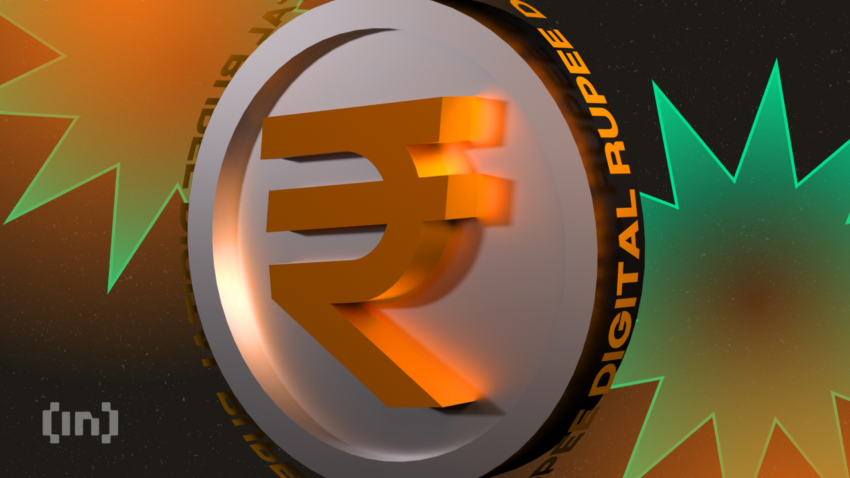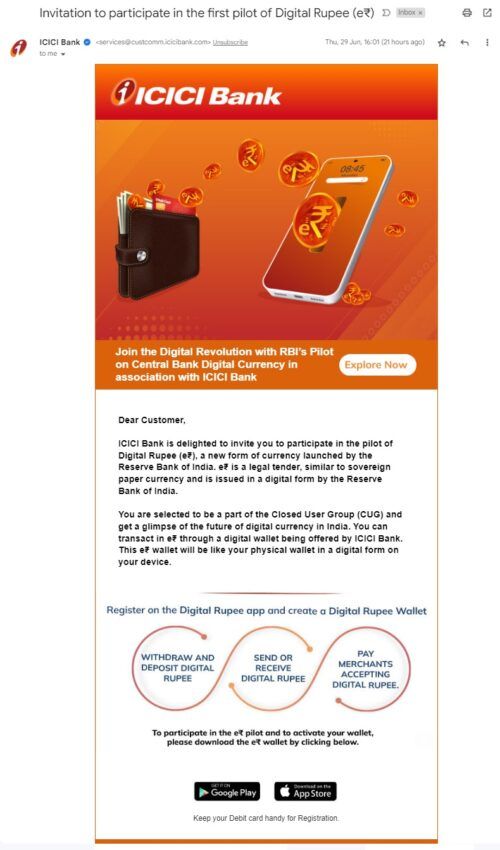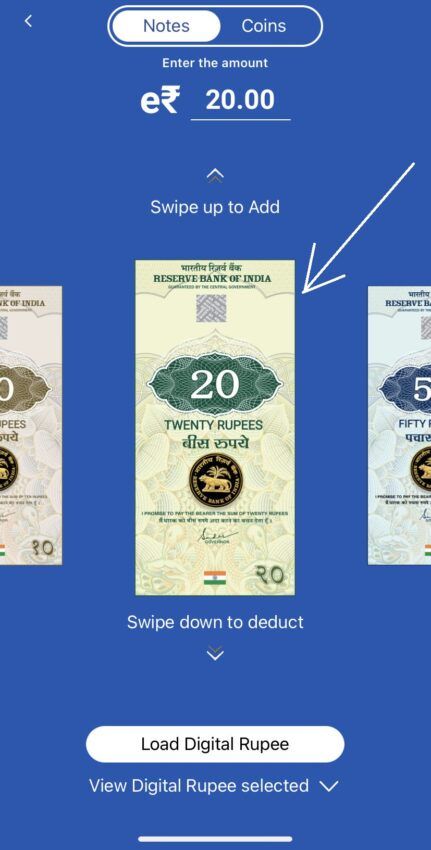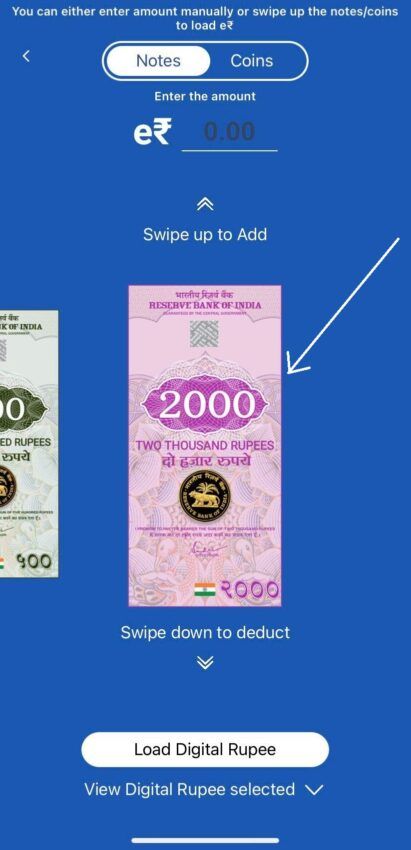The e-rupee (e₹), India’s very own central bank digital currency (CBDC), has been making waves in the financial news circuit in 2023. This flagship initiative by the Indian Government aims to improve financial inclusion and further embed digital finance across the country. Also known as the digital rupee or the Indian CBDC, the digital rupee was first brought to the public’s attention by Finance Minister Nirmala Sitharaman during her 2022 Budget speech. The Reserve Bank of India (RBI) took the reins from there, launching two pilot projects, with the first one taking flight in Q4 2022.
In June 2023, we received an invite to try out one of these pilot projects (the pilot projects are currently invite-only). This provided us with an up-close look at the key components of India’s CBDC infrastructure. Read on for an in-depth look at what the digital rupee is, its vision, and how it differs from other digital payment platforms.
- What is a CBDC?
- What is the Indian e-rupee?
- Digital rupee: Timeline, stakeholders, and scope
- How to join RBI’s digital rupee pilot
- Digital rupee denominations
- What does the digital rupee look like?
- Digital rupee: Key features and traits
- What is the difference between UPI and e-rupee?
- Could privacy be a concern with the digital rupee?
- Digital rupee: The pros and cons
- A calibrated, gradual implementation is the key
What is a CBDC?

Central Bank Digital Currencies, or CBDCs for short, are like the digital twins of a country’s physical currency. Central banks create and issue them, and they adhere to the same regulations as their physical equivalents.
Don’t mistake them for cryptocurrencies, though. While both are digital, cryptocurrencies are generally decentralized and governed by a community. In contrast, CBDCs are centralized, issued, and controlled by the central bank.
CBDCs come in two flavors: wholesale and retail. You could think of wholesale CBDCs as the behind-the-scenes workers used by banks and financial institutions for things like interbank settlements. On the other hand, retail CBDCs are the ones you and I would use, just like we use cash for everyday purchases.
One of the advantages of CBDCs is that they promise to make financial transactions faster and more efficient. They could even help people in remote or underserved areas access money. Plus, they could provide a more stable form of money, less prone to the rollercoaster ride of inflation than other digital assets such as bitcoin.
That said, CBDCs come with their fair share of challenges. Implementing them involves setting up a whole new digital infrastructure, which can be complex. And then there are privacy and security concerns. For instance, with digital currencies, it could be easier for governments and other parties to keep an eye on individuals’ financial transactions. Could such loopholes be present in the e-rupee too? We will address that question later on.
Broadly speaking, CBDCs are still in their infancy at a conceptual level. We’ll get a clearer picture of their benefits and disadvantages only as they grow and develop.
What is the Indian e-rupee?
The digital rupee or e-rupee (e₹) is a CBDC issued by the Reserve Bank of India (RBI). It’s the digital counterpart of our familiar physical rupee (INR).
As the name suggests, instead of being issued as paper money (physical currency), the digital rupee is issued as a digital token that represents the Indian rupee. Just like its physical counterpart, the e-rupee is a legal tender, accepted as a medium of payment and a safe store of value.
Digital rupee in a nutshell:
- The digital rupee or e-rupee is an RBI-issued sovereign digital currency.
- Although it uses blockchain technology, the digital rupee is not actually a cryptocurrency. While cryptocurrencies like bitcoin and ethereum are decentralized, the digital rupee is not.
- It is a legal tender, and you can use it just as you would cash — for example, to buy groceries.
- It is interchangeable with physical currency. For example, once it is publicly available across India, you should be able to walk into any bank and exchange your cash for digital rupees of equal value.
- The digital rupee appears as a liability in the RBI balance sheet. This liability is there because the RBI is responsible for maintaining and ensuring the value of the digital rupee.
- The RBI aims to make the digital rupee a completely fungible asset that anyone can use regardless of whether they have a bank account or not.
Digital rupee: Timeline, stakeholders, and scope

Before the retail digital rupee made its debut, there was the digital rupee for Wholesale, or e₹-W, which took its first digital steps on Nov.1, 2022. The RBI’s objective with the e₹-W was to use it to settle secondary market transactions in government securities. The RBI is optimistic that it will reduce the cost of transactions while simultaneously removing the need for settlement guarantee infrastructure or collateral to mitigate settlement risks.
The journey of the digital rupee for Retail (e₹-R) officially kicked off with the first pilot for CBDC-Retail, announced on Dec.1, 2022. One of the main objectives of the pilot was to try out the e-rupee as a legal tender carrying the trust, safety, and settlement finality of physical cash.
This pilot took off in the cities of New Delhi, Mumbai, Bengaluru, and Bhubaneswar. Initially, it was available to a select group of customers and merchants forming a close-knit community, or as the tech community likes to call it, a closed user group (CUG).
The digital rupee didn’t stay confined to these cities for long as the RBI expanded the piliot to other locations including Chandigarh, Ahmedabad, Kochi, Guwahati, Gangtok, Hyderabad, Shimla, Patna, and Lucknow.
The pilot began with four banks – the State Bank of India, YES Bank, IDFC First Bank, and ICICI Bank, taking the lead. Four other banks, including Union Bank of India, Kotak Mahindra Bank, HDFC Bank, and Bank of Baroda, soon followed suit. The crew is still expanding, with five more banks including Axis Bank, Canara Bank, IndusInd Bank, Punjab National Bank, and Federal Bank either joining or slated to join the ranks.
How to join RBI’s digital rupee pilot
The pilot program is currently limited to invitation-only, exclusively extended to individuals who have been invited by their respective banks.

Once you receive an invitation, you can proceed to download the digital rupee app of your bank and start using it.
Digital rupee denominations
The digital rupee has the same denominations as those you are familiar with in real life — the same physical currency denominations. You get coins of 50 paise (₹0.50) and ₹1 and then tokens of ₹2 all the way up to ₹2,000.
That means, as of early-July 2023, you’ll find digital tokens for e₹0.50, e₹1, e₹2, e₹5, e₹10, e₹20, e₹50, e₹100, e₹200, e₹500, and even e₹2,000.: e₹0.50, e₹1, e₹2 e₹5, e₹10, e₹20e, e₹50, e₹100, e₹200, e₹500, e₹2,000.
Now, you might be wondering what if you need to send or receive an amount that doesn’t fit neatly into these denominations, like e₹10.43 or e₹10.11? Well, the digital rupee system has a solution for that. It’s a bit like a digital shopkeeper who doesn’t have the exact change — except that it would simply round off the amount instead of offering candies as a sweet substitute in lieu of change. (For the uninitiated, some Indian shopkeepers offer customers candies as a “substitute currency” when they can’t “coin” their way out of giving exact change.)
Here’s how it works: the system rounds off the figure being sent or received to the nearest available denomination. So, if you’re dealing with e₹10.43, the system will round it off to e₹10.50. And if it’s e₹10.11, the system will round it down to e₹10.
What does the digital rupee look like?
Being a digital currency, the e-rupee doesn’t have a physical form. However, to ease users into this new digital landscape, the RBI has cleverly represented each digital rupee denomination with graphics that bear a striking resemblance to their physical currency counterparts.
For instance, this is the e₹20 token:

And here is the e₹2,000 token:

Notice the resemblance with actual physical currency denominations of equal value? (On a side note, the e₹2,000 may soon be discontinued as ₹2,000 physical currency notes are already being phased out.)
Just like a physical rupee note carries the RBI name and logo, along with the signature of the RBI Governor, the digital rupee does too. Each token is assigned a unique serial number, a digital fingerprint of sorts. This serial number can be used to track the specific token on the blockchain, adding an extra layer of security and traceability.

Digital rupee: Key features and traits
Here’s a rundown of some of the key traits and features of the digital rupee:
- Digital representation: The digital rupee is a digital representation of the Indian rupee. Each digital token represents a specific denomination, just like a physical currency.
- Legal tender: Just like the physical rupee, the digital rupee is a legal tender. This means it’s recognized by the government as a valid form of payment.
- Instant transactions: One of the biggest advantages of the digital rupee is the speed of transactions. Payments and transfers are processed instantly, making your financial dealings faster and more efficient.
- Accessibility: The digital rupee is designed to be accessible to everyone, regardless of their location. This could potentially improve financial inclusion, especially in remote or underserved areas.
- Interoperability: The digital rupee is designed to be interoperable with other payment systems. This means you can use it alongside your other digital payment apps.
- Privacy: While the digital rupee allows for traceability of transactions, it also respects users’ privacy. The design ensures that while illegal activities can be traced and prevented, the privacy of ordinary users is respected. More on that in a bit.
Remember, these are just some of the main features of the digital rupee. As the technology evolves and matures, we can expect to see even more features and capabilities added to India’s CBDC infrastructure.
What is the difference between UPI and e-rupee?
The e-rupee is a digital form of currency, enabling transactions directly from your digital wallet. You can withdraw e-rupee from your bank account, tuck it into your digital wallet on your phone, and then spend it at any shop, just like you would with physical cash.
“In CBDC, you will draw the digital currency and keep it in your wallet on your mobile. When you make a payment at a shop or to another individual, it will move from your wallet to their wallet. There is no routing or intermediation of the bank.”
– T Rabi Sankar, Deputy Governor, RBI, at Post Monetary Policy Press Conference held in Dec. 2022.
UPI, on the other hand, is a platform facilitating digital transactions. When you use UPI, you’re essentially instructing your bank to move money from your account to the vendor’s account. You can use various methods like debit or credit cards, net banking, or mobile wallets to execute payments via UPI.
So, while both e-Rupee and UPI are key players in the digital finance game, they play very different roles. One is the digital equivalent of physical cash, and the other is a platform that facilitates digital transactions.
Could privacy be a concern with the digital rupee?
Quite the opposite instead. Due to the nature of how digital wallet transactions work, it may offer better privacy than the average UPI app you probably use. That’s because the digital rupee transaction takes place peer-to-peer.
Consider this — you go to a shop and buy a pack of chips by paying with a crisp Rs 20 note. Is there a centralized log or record of this transaction? Not likely! The e-Rupee operates on the same principle, at least for relatively low-value transactions. The RBI has even given the official nod, stating that such transactions will be anonymous.
However, that’s not the same with UPI apps like Google Pay or Amazon Pay. Records of any transaction done through these apps — however big or small — are stored centrally in their servers. So the level of anonymity offered by UPI is far less comparatively.
While the Digital Rupee does offer a degree of anonymity for smaller transactions, it’s important to remember that it operates on a centralized infrastructure. This means that the RBI can trace the transactions of an individual or entity on the blockchain. It can even track the journey of individual tokens as they move across the blockchain.
However, the RBI assures that this capability will be primarily used to trace high-value transactions. The aim is to ensure legal compliance and security rather than playing Big Brother on every minor transaction. So, while the Digital Rupee offers some privacy, it also has the necessary checks and balances in place to enforce transparency as and when required.
Digital rupee: The pros and cons
Pros
- Speedy transactions: Digital rupee transactions are much faster than traditional methods like automated clearing houses or wire transfers, which can take days for financial institutions to confirm transactions.
- Cost-effective global transfers: International transactions can often be a costly affair. The e-rupee could at least partially resolve this by making these transactions more cost-effective and swift. Not just that, it could also save you from hefty fees.
- Round-the-clock availability: Unlike traditional banking systems that clock out after working hours or over the weekend, digital currency transactions are always on the job, operating 24/7. This means your transactions are processed at the same speed, regardless of the time or day.
- No physical manufacturing: Digital currencies don’t need a physical manufacturing facility, saving on those costs. Plus, they’re immune to the physical wear and tear that physical currency is subject to.
- Efficient government payments: The e-rupee could help the government to streamline payouts such as subsidies, tax refunds, scholarships, etc.
Cons
- Challenges for the banking system: The introduction of CBDCs could significantly impact the banking system. If the Digital Rupee becomes an attractive savings option, it could lead to a decrease in bank deposits. This could have a ripple effect on other areas, such as credit creation and the RBI’s monetary policy stance.
- Potential for financial instability: If the RBI were to offer interest rates on the Digital Rupee, it could end up competing with the same banks it regulates. This could potentially destabilize the banking system, putting depositors at risk.
- Cybersecurity concerns: As the popularity of the e-rupee increases, so does the risk of attracting financially motivated cyber attacks.
- Government control: The Digital Rupee, being under government control, could significantly impact monetary policies. If it becomes a widely accepted alternative form of currency, this could potentially dilute the RBI’s control over inflation. This could then compel the government to modify its macroeconomic policies to remain competitive.
A calibrated, gradual implementation is the key
Following the success of UPI, the digital rupee marks another significant stride in India’s ongoing journey towards building a robust digitized economy. It promises to offer a safer, cost-effective, and efficient mode of transaction, while also addressing potential challenges related to banking and monetary policy, among other things.
That said, CBDCs, including the digital rupee, are in their early stages of development, both conceptually and technologically. As such, comprehensive research is needed to fully grasp their potential impact on India’s financial system. Given this context, a measured and phased rollout without stifling innovation seems to be the most prudent approach.
What is Indian e-Rupee?
How is UPI different from the e-Rupee?
What is the use of e-rupee?
Which banks are involved in e-rupee?
Trusted
Disclaimer
In line with the Trust Project guidelines, the educational content on this website is offered in good faith and for general information purposes only. BeInCrypto prioritizes providing high-quality information, taking the time to research and create informative content for readers. While partners may reward the company with commissions for placements in articles, these commissions do not influence the unbiased, honest, and helpful content creation process. Any action taken by the reader based on this information is strictly at their own risk. Please note that our Terms and Conditions, Privacy Policy, and Disclaimers have been updated.




